I bet you’re reading this while that scraped skin is still throbbing from your carpet encounter.
Maybe you just slipped in your socks, took a tumble during family game night, or your little one is crying over their latest indoor play gone wrong.
Trust me, I get it, that burning sensation is impossible to ignore, and you’re probably wondering if you’re treating it right. The good news? You can absolutely handle this at home with the right steps.
Let’s get you feeling better without any more tears or worry.
What Exactly is a Rug Burn?
A rug burn is essentially what happens when your skin comes into contact with a carpet and loses.
Technically, it’s called a friction burn or abrasion, which means the top layer of your skin gets scraped off from rubbing against a rough surface.
Think of it like this: when you slide across carpet or fall onto a rough surface, your skin and that surface create friction.
If there’s enough pressure and movement, the friction literally scrapes away the outer layer of your skin. It’s the same concept as getting road rash from falling off a bike, just with carpet instead of pavement.
While rug burns are usually minor injuries that heal on their own with proper care, they still deserve attention. That raw, exposed skin is sensitive to bacteria and infection, so treating it right from the start makes a big difference.
How Do You Get a Rug Burn?
Rug burns love to show up during these common scenarios:
- Active Play and Sports: Kids sliding in their socks, wrestling matches on the living room floor, or indoor sports where you might slide across carpet or gym mats.
- Accidental Falls: Tripping and catching yourself with your hands or knees on carpet, especially when you’re wearing shorts or have exposed skin.
- Exercise Activities: Doing floor exercises, yoga, or stretching on rough surfaces without proper mats.
- Rough Surfaces: The culprits are usually coarse carpets, outdoor rugs, artificial turf, exercise mats with texture, or any surface that feels rough to the touch.
The rougher the surface and the more friction involved, the more likely you are to end up with that familiar burning sensation.
What Does a Rug Burn Look and Feel Like?
When dealing with a burn, the symptoms and severity can vary greatly depending on the depth and extent of the injury. Differentiating between the degrees of burns is crucial for proper treatment and care.
The following table outlines the key characteristics of minor, moderate, and severe burns.
| Burn Degree | Affected Skin Layers | Key Signs & Symptoms |
| Minor (First-Degree) | Epidermis (top layer) | Redness, tenderness, and slight discoloration. The skin is dry with no blisters. |
| Moderate (Second-Degree) | Epidermis and Dermis | Blistering is the main sign. The skin may look shiny or wet. These burns are more painful. |
| Severe (Third-Degree) | All layers of skin (and sometimes deeper tissue) | Deep skin damage with a charred, waxy white, or leathery appearance. There may be numbness due to nerve damage. |
Potential Complications to Watch For
Regardless of the initial severity, burns can lead to several complications. Be on the lookout for signs of infection, such as increased redness, swelling, or pus. Other potential issues include permanent scarring and “traumatic tattooing” from embedded debris if the wound isn’t cleaned properly.
Knowing the difference between burn degrees helps you decide on the right course of action, from at-home care for minor burns to seeking immediate medical attention for more severe ones.
How to Treat Your Rug Burn at Home?
Step 1: Get Your Hands Clean and Assess the Damage
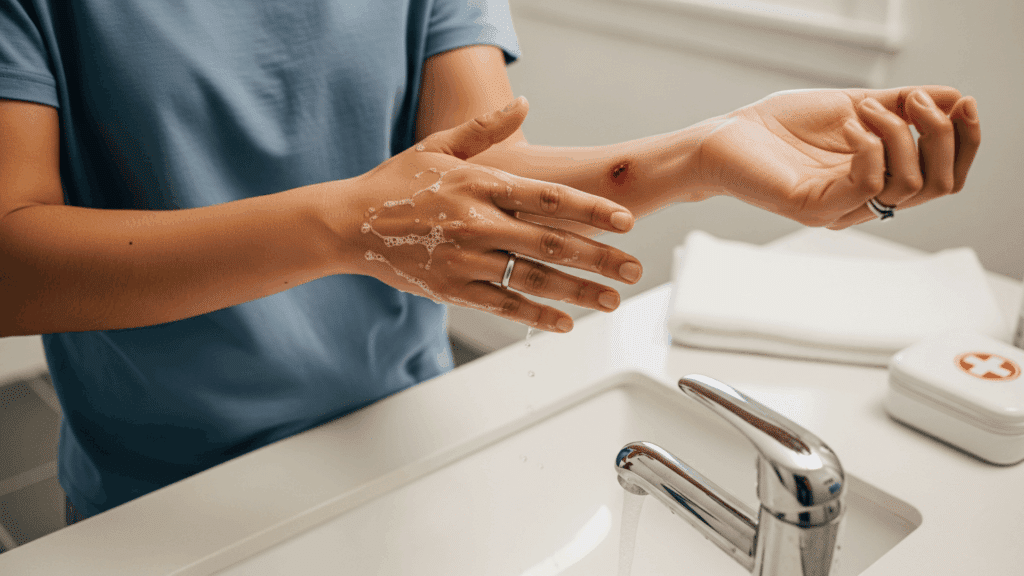
Before you touch the injured area, wash your hands thoroughly with soap and warm water. This prevents the introduction of bacteria to the wound. Take a close look at the rug burn to assess its severity.
Pay attention to the size of the scrape, the depth of the skin damage, and whether there’s active bleeding. If the area appears more than just superficial, keep in mind that you may need medical attention.
Taking these few minutes up front can make a big difference in how quickly the wound heals.
Step 2: Clean the Wound Gently
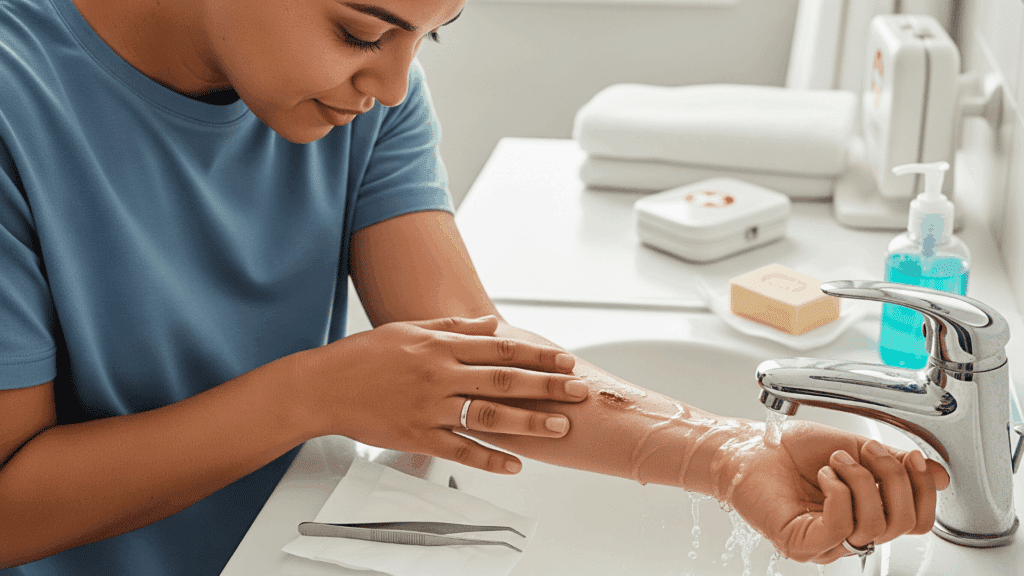
Rinse the rug burn with cool, clean water. This removes any dirt, carpet fibers, or debris that might be stuck to the wound. You can use mild soap if needed, but be gentle; scrubbing will only make the pain worse.
Pat the area dry with a clean towel. If you notice stubborn debris, use clean, sterilized tweezers to carefully remove it.
Take your time; rushing may irritate the wound further. Think of this step as giving the injury a fresh, clean start so it can heal without infection.
Step 3: Stop Any Bleeding
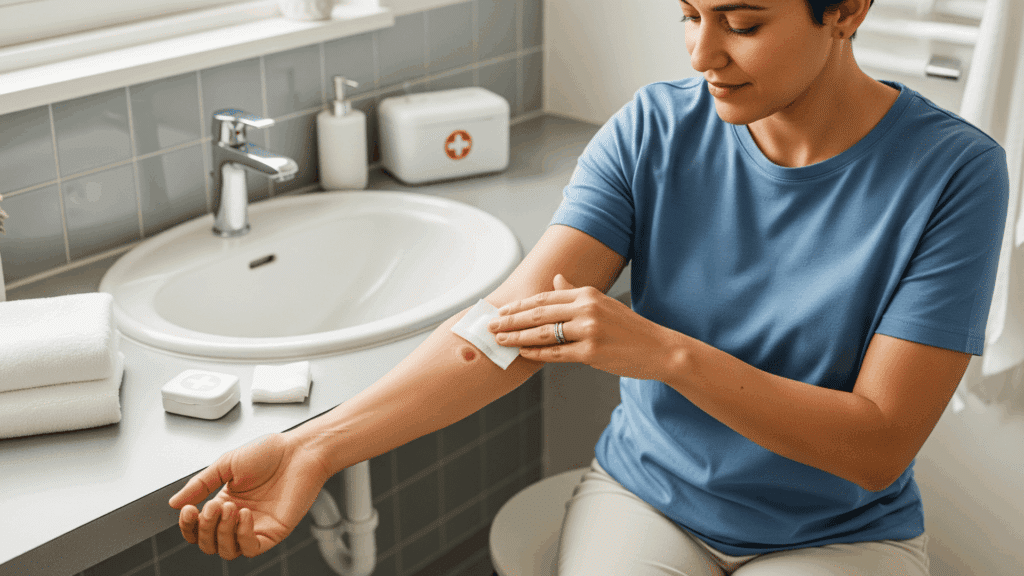
If there’s bleeding, apply gentle pressure with a clean cloth or gauze pad. Most rug burn bleeding is minor and stops quickly with a little pressure.
Maintain steady pressure for several minutes instead of checking too often; this allows the clotting process to occur. If bleeding doesn’t slow down after 10 minutes, it’s a good idea to seek medical advice.
Once bleeding stops, avoid peeling away any tiny scabs that form, as they’re nature’s first bandage.
Step 4: Apply Protective Treatment
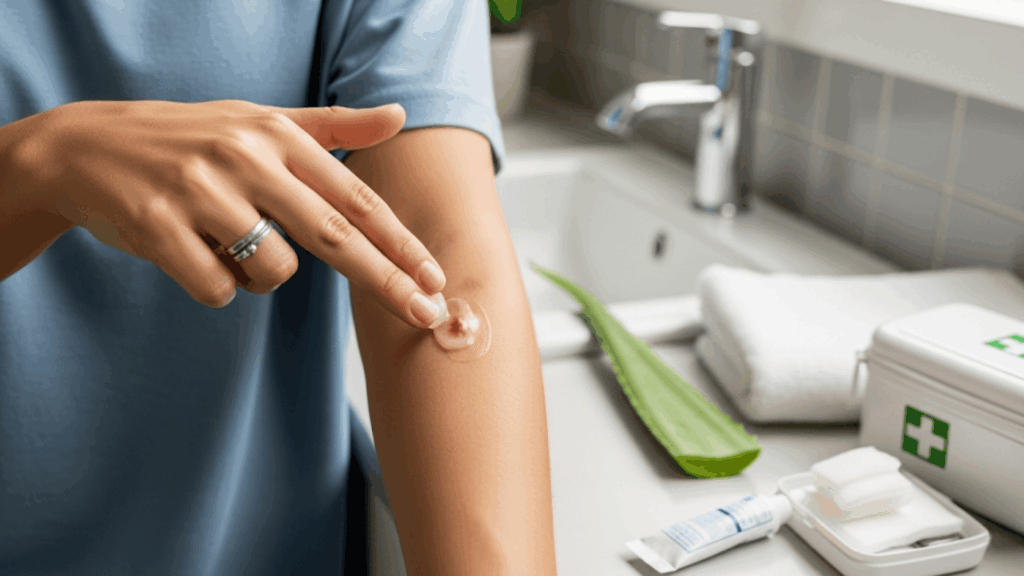
Now for the healing helpers:
Antibiotic ointment: A thin layer of over-the-counter ointment like Neosporin helps prevent infection and keeps the wound moist for better healing.
Alternative options: If you don’t have ointment, petroleum jelly, or aloe vera gel can provide moisture and protection.
Remember, moisture is key to reducing scarring and speeding recovery. A dry wound is more likely to crack and take longer to heal.
Step 5: Cover It Up
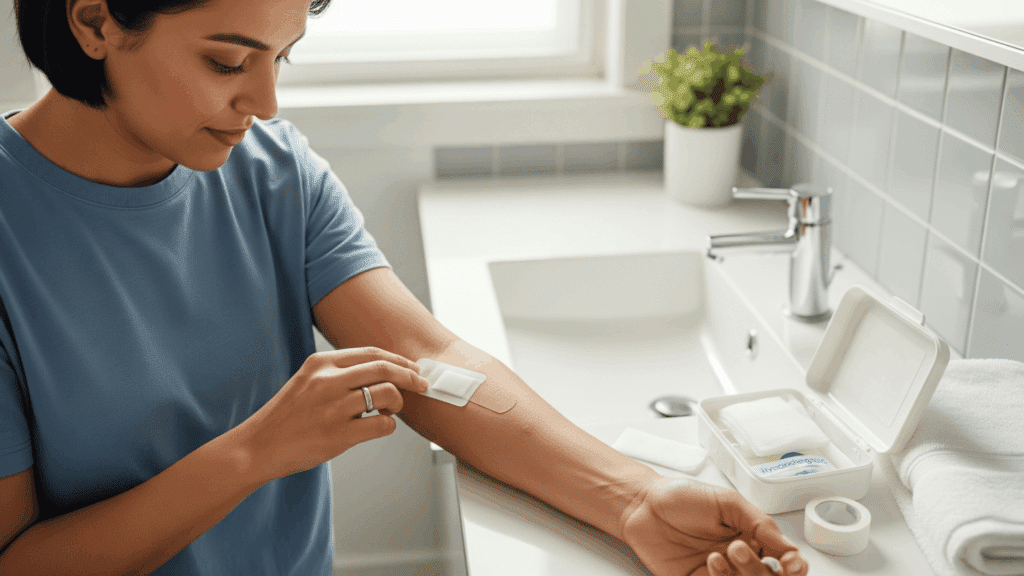
Use a clean adhesive bandage or gauze pad to cover the rug burn. This protects it from further rubbing against clothing and keeps dirt out. Change the dressing daily or as soon as it becomes wet, dirty, or starts to come loose.
Choose breathable dressings that allow airflow while still shielding the skin. For larger rug burns, medical gauze with hypoallergenic tape may be more comfortable than smaller bandages.
Covering the wound also helps reduce the temptation to scratch or touch it, which is one of the biggest causes of delayed healing.
At-Home Burn Care & Healing Process
For minor burns, proper at-home care is crucial for a fast and effective healing process. Following a simple routine can help prevent infection and minimize scarring.
| Care Category | Action | Why It Helps | Timeline |
| Initial Treatment | Run the burn under cool, not cold, water for 10-20 minutes. | Stops the burning process and reduces pain and swelling. | Immediately after the burn. |
| Wound Maintenance | Gently wash with mild soap and water daily. Apply a thin layer of petroleum jelly and cover with a non-stick bandage. | Prevents infection and creates a moist environment for faster healing. | Daily, or as advised by a doctor. |
| Managing Blisters | Do not pop blisters. | Blisters protect the new skin underneath and reduce the risk of infection. | They will heal and flatten on their own. |
| Signs to Watch For | Monitor for increasing redness, swelling, pus, or a fever. | These are signs of a potential infection that requires professional medical care. | Seek medical help immediately if these appear. |
| Expected Recovery | Minor burns typically heal within 2-7 days. | This is a normal part of the body’s repair process. | Timeline varies with burn severity. |
Did you know? Letting a burn “breathe” can actually slow healing. Covering it and keeping it moist is the best way to speed up recovery!
When to Seek Medical Care?
Seek medical care right away if a friction burn causes blisters over large areas or on sensitive spots like your face, hands, feet, or genitals.
Watch for signs of infection, such as increased pain, redness, swelling, bad odor, or oozing from the wound. If the burn doesn’t heal as expected or seems to get worse, see a healthcare provider. Serious burns that go deep into the skin or are full-thickness need expert medical attention.
These may require special treatments like skin grafts to heal properly. Getting timely care can help prevent infection and long-term problems such as scarring or tissue damage.
When in doubt, it’s safer to get checked by a doctor to ensure proper healing and treatment.
How to Prevent Future Rug Burns?
Taking proactive steps can significantly reduce the risk of scrapes and abrasions. Here are some simple prevention tips to keep you and your family safe.
- Wear protective gear like knee/elbow pads during sports or play.
- Use soft, low-pile rugs in play areas to minimize friction.
- Place cushioned runners in high-traffic zones of your home.
- Ensure exercise equipment is stored safely away from children.
- Choose rugs with soft textures that won’t cause friction burns.
By making a few simple adjustments and taking precautions, you can create a safer environment for everyone.
Final Thoughts
See? Treating a rug burn isn’t as scary as it feels in that first stinging moment.
You’ve got everything you need to handle this at home. Just keep it clean, covered, and give your skin time to work its healing magic.
Most rug burns are completely healed within a week or two, and before you know it, this will just be another “remember when” story.
Just remember: if something doesn’t feel right or you notice signs of infection, don’t hesitate to call your doctor. You know your body best, and there’s no harm in getting a professional opinion when you need peace of mind.














